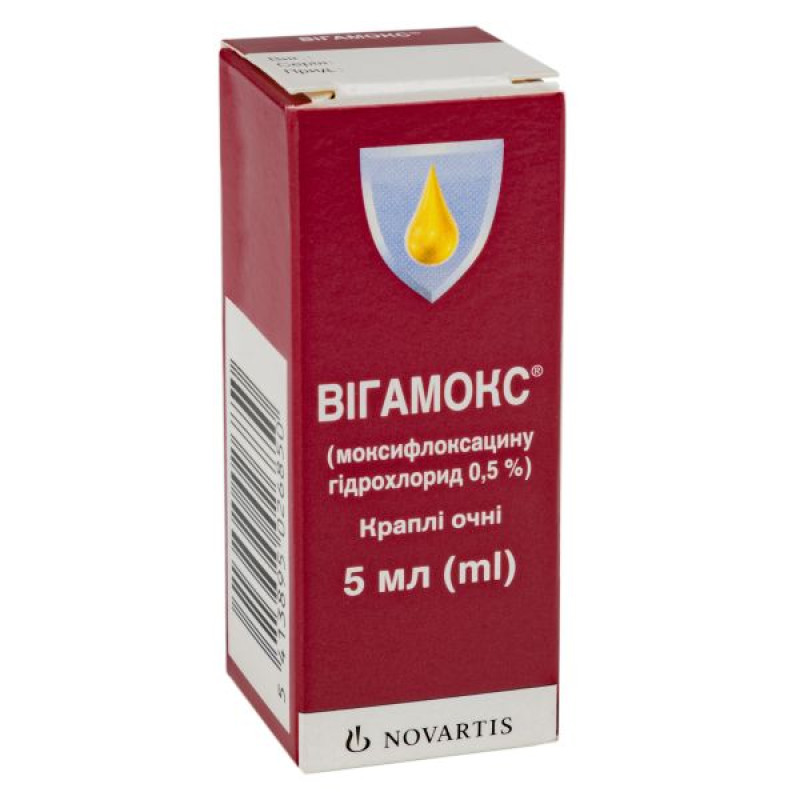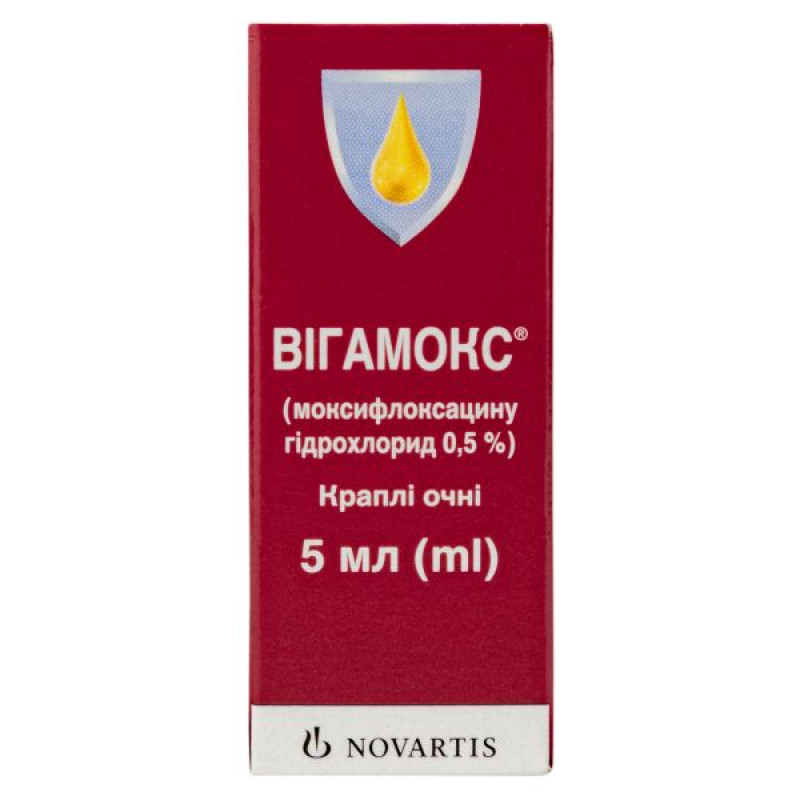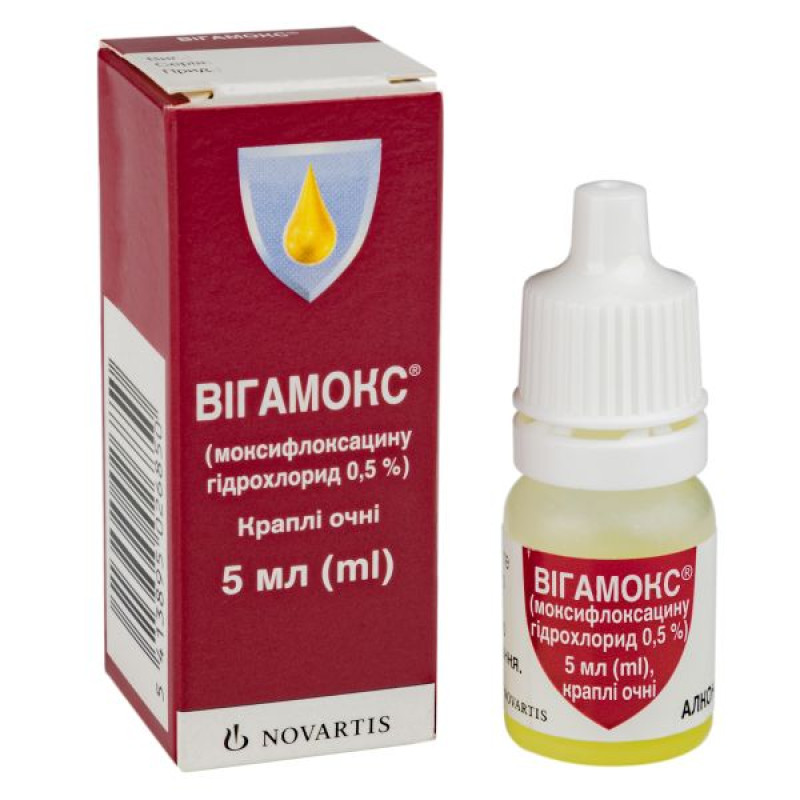Vigamox eye drops 0.5% dropper bottle drop-tainer 5 ml

Instructions Vigamox eye drops 0.5% dropper bottle drop-tainer 5 ml
Composition
active substance: moxifloxacin; 1 ml of solution contains 5.45 mg of moxifloxacin hydrochloride, which is equivalent to 5 mg of moxifloxacin;
excipients: sodium chloride, boric acid, sodium hydroxide and/or concentrated hydrochloric acid (for pH adjustment), purified water.
Dosage form
Eye drops.
Main physicochemical properties: transparent, greenish-yellow solution.
Pharmacotherapeutic group
Means used in ophthalmology. Antibacterial agents. ATX code S01A E07.
Pharmacological properties
Pharmacodynamics.
Mechanism of action
Moxifloxacin, a fourth-generation fluoroquinolone, inhibits DNA gyrase and topoisomerase IV, which are essential for bacterial DNA replication, repair, and recombination.
Mechanism of resistance
Resistance to fluoroquinolones, including moxifloxacin, usually occurs due to chromosomal mutations in the genes encoding DNA gyrase and topoisomerase IV. In Gram-negative bacteria, resistance to moxifloxacin can occur due to mutations in the mar (multidrug resistance) and qnr (quinolone resistance) gene systems. Cross-resistance with beta-lactams, macrolides and aminoglycosides is unlikely due to differences in the mode of action.
Limit values
The European Committee on Antibiotic Susceptibility Testing (EUCAST) has established the following minimum inhibitory concentration (MIC) breakpoints (mg/L):
| Staphylococcus species | S ≤ 0.5, R> 1 |
| Streptococcus A,B,C,G | S ≤ 0.5, R> 1 |
| Streptococcus pneumoniae | S ≤ 0.5, R> 0.5 |
| Haemophilus influenzae | S ≤ 0.5, R> 0.5 |
| Moraxella catarrhalis | S ≤ 0.5, R> 0.5 |
| Enterobacteriaceae | S ≤ 0.5, R> 1 |
| non-specific | S ≤ 0.5, R> 1 |
In vitro breakpoints are used to predict the clinical efficacy of moxifloxacin when administered systemically. These breakpoints may not be acceptable when the drug is administered topically to the eye, as higher concentrations are used with topical administration and local physical/chemical conditions may affect the activity of the drug at the site of administration.
Sensitivity
The prevalence of acquired resistance may vary geographically and over time for the relevant species of microorganisms, therefore it is desirable to have local information on the resistance of microorganisms, especially when treating severe infections.
If necessary, specialist advice should be sought if the local prevalence of resistance is such that the activity of moxifloxacin, at least against some types of infections, is questionable.
| SENSITIVE SPECIES |
Aerobic gram-positive microorganisms: Corynebacterium species, including Corynebacterium diphtheriae Staphylococcus aureus (methicillin-susceptible) Streptococcus pneumoniae Streptococcus pyogenes Streptococcus viridans group Aerobic Gram-negative microorganisms: Enterobacter cloacae Haemophilus influenzae Klebsiella oxytoca Moraxella catarrhalis Serratia marcescens Anaerobic microorganisms: Proprionibacterium acnes Other microorganisms: Chlamydia trachomatis |
| CONDITIONALLY RESISTANT SPECIES |
Aerobic gram-positive microorganisms: Staphylococcus aureus (methicillin-resistant) Staphylococcus, coagulase-negative species (methicillin-resistant) Aerobic Gram-negative microorganisms: Neisseria gonorrhoeae Other microorganisms Missing |
| RESISTANT MICROORGANISMS |
Aerobic Gram-negative microorganisms: Pseudomonas aeruginosa Other microorganisms Missing |
Preclinical safety data
In non-clinical studies, effects following topical ocular administration were observed only at doses significantly in excess of the maximum human dose, indicating little relevance to clinical use.
As with other quinolones, moxifloxacin has also been shown to be genotoxic in vitro in bacterial and mammalian cells. A threshold level for genotoxicity can be suggested, as at much higher concentrations these effects may result in interactions with bacterial gyrase and topoisomerase II in mammalian cells. In vivo studies, despite high doses of moxifloxacin, no evidence of genotoxicity was found. Thus, therapeutic doses for humans provide an adequate level of safety. No signs of carcinogenicity were observed in preclinical studies in rats.
Unlike other quinolones, moxifloxacin did not demonstrate any phototoxic or photogenotoxic properties in extensive in vitro and in vivo studies.
After topical application of Vigamox® eye drops, moxifloxacin was absorbed into the systemic circulation. Plasma concentrations of moxifloxacin were determined in 21 male and female subjects who received topical instillation of the drug into both eyes 3 times daily for 4 days. The mean Cmax and AUC values in plasma were 2.7 ng/ml and 41.9 ng h/ml, respectively. These values are approximately 1600 and 1200 times lower than the mean Cmax and AUC values reported after oral administration of therapeutic doses of moxifloxacin of 400 mg. The plasma half-life of moxifloxacin is 13 hours.
Indication
Topical treatment of bacterial conjunctivitis caused by moxifloxacin-susceptible strains of bacteria. For information on the appropriate use of antibacterial agents, refer to official guidelines.
Contraindication
Hypersensitivity to the active substance, other quinolones or to any of the components of the drug.
Interaction with other medicinal products and other types of interactions
No drug interaction studies have been conducted. Drug interactions are unlikely because moxifloxacin has low systemic concentrations when applied topically to the eye. If several topical ophthalmic drugs are administered simultaneously, the interval between their administration should be at least 5 minutes. Eye ointments should be applied last.
Application features
For ophthalmic use only. Not for injection. Vigamox® should not be administered by subconjunctival injection or directly into the anterior chamber of the eye.
Serious, sometimes fatal, hypersensitivity (anaphylactic) reactions have been reported in patients receiving systemic quinolone therapy, sometimes after the first dose. Some reactions have been associated with cardiovascular failure, loss of consciousness, angioedema (including laryngeal, pharyngeal and facial swelling), airway obstruction, dyspnoea, urticaria and pruritus.
If an allergic reaction to Vigamox® eye drops occurs, the drug should be discontinued. Serious acute hypersensitivity reactions to moxifloxacin or any component of this medicinal product may require emergency treatment. If clinically indicated, airway patency should be restored and oxygen therapy should be administered.
As with other antibiotics, prolonged use of Vigamox® eye drops may result in overgrowth of non-susceptible organisms, including fungi. If superinfection occurs, treatment should be discontinued and appropriate therapy instituted.
Tendon inflammation and rupture may occur with systemic fluoroquinolone therapy, including moxifloxacin, especially in elderly patients, and with concomitant use with corticosteroids. At the first signs of tendon inflammation, treatment with Vigamox® eye drops should be discontinued.
It is not recommended to wear contact lenses during treatment of eye inflammation/infections.
The drug is not prescribed to children under 2 years of age for the treatment of eye diseases caused by Chlamydia trachomatis, as its effect has not been studied in this category of patients. Children over 2 years of age with eye diseases caused by Chlamydia trachomatis should receive appropriate systemic treatment. Newborns should receive appropriate systemic treatment in case of eye diseases caused by Chlamydia trachomatis or Neisseria gonorrhoeae.
Use during pregnancy or breastfeeding
Reproductive function
No studies have been conducted on the effects of Vigamox® on human reproductive function when applied topically.
No adverse reactions on the reproductive function of men or women have been reported during the use of Vigamox® eye drops.
Pregnancy
Since there are no adequate and well-controlled studies of the drug in pregnant women, Vigamox® should not be used during pregnancy unless the potential benefit outweighs the potential risk to the fetus.
Lactation period
It is not known whether moxifloxacin or its metabolites are excreted in human milk. Animal studies have shown low levels of oral moxifloxacin excretion. Vigamox® should be administered with caution to breastfeeding women.
Ability to influence reaction speed when driving vehicles or other mechanisms
Vigamox® eye drops has no or negligible influence on the ability to drive or use machines. Temporary blurred vision or other visual disturbances may affect the ability to drive or use machines. If blurred vision occurs during instillation, the patient should wait until the vision clears before driving or using machines.
Method of administration and doses
For ophthalmic use.
Instill 1 drop into the affected eye(s) 3 times a day.
Usually the condition improves within 5 days, after which the treatment should be continued for another 2-3 days. If no improvement is observed within 5 days of treatment, you should consult a doctor for clarification of the diagnosis and/or treatment. The duration of treatment depends on the severity of the disease and the clinical and bacteriological picture of the course of the disease.
Children
No dose adjustment is necessary for this category of patients.
Patients with impaired liver and kidney function
There is no need for dose adjustment for this category of patients.
To prevent contamination of the dropper tip and contents of the bottle, care should be taken not to touch the eyelids, surrounding areas, or other surfaces with the dropper tip.
To prevent absorption of drops through the nasal mucosa, especially in newborns and children, occlusion of the nasolacrimal duct for 2–3 minutes after application of the drops is recommended.
Not for injection. Vigamox® should not be administered by subconjunctival injection or directly into the anterior chamber of the eye.
Children.
In clinical studies, Vigamox® eye drops was found to be safe in children, including neonates. Two adverse reactions were reported in patients under 18 years of age: eye irritation and eye pain (incidence 0.9%). See also section “Special warnings and precautions for use”.
Overdose
Given the characteristics of the drug, no toxic effect is expected in case of overdose when applying the drug to the eye or in case of accidental swallowing of the contents of one vial.
Side effects
In clinical studies, the most common adverse reactions were eye pain and eye irritation, occurring in approximately 1-2% of patients.
The following adverse reactions observed during clinical trials with Vigamox® are classified by frequency as follows: very common (≥1/10), common (≥1/100 to <1/10), uncommon (≥1/1000 to <1/100), rare (≥1/10,000 to <1/1000) and rare (<1/10,000). Within each group, adverse reactions are presented in order of decreasing seriousness.
| Organ system | Adverse reactions according to MedDRA (version 15.1) |
| Disorders of the circulatory and lymphatic systems | Rare: decreased hemoglobin level |
| Nervous system disorders | Uncommon: headache Uncommon: paraesthesia |
| Ophthalmological disorders | Common: eye pain, eye irritation Uncommon: punctate keratitis, dry eye syndrome, conjunctival haemorrhage, conjunctival hyperaemia, ocular hyperaemia, ocular pruritus, abnormal ocular sensitivity, eyelid oedema, ocular discomfort Uncommon: corneal epithelial defect, corneal disorder, corneal discoloration, conjunctivitis, blepharitis, eye swelling, eyelid pain, conjunctival edema, blurred vision, decreased visual acuity, asthenopia, eyelid disorder, eyelid erythema. |
| Respiratory, thoracic and mediastinal disorders | Uncommon: nasal discomfort, pharyngolaryngeal pain, foreign body sensation (in the throat) |
| Gastrointestinal disorders | Uncommon: dysgeusia Uncommon: vomiting |
| Liver and biliary tract disorders | Uncommon: increased alanine aminotransferase, increased gamma-glutamyltransferase |
Additional adverse reactions have been identified during post-marketing surveillance. It is not possible to estimate their frequency. Within each system organ class, adverse reactions are presented in order of decreasing seriousness.
| Organ system | Adverse reactions according to MedDRA (version 15.1) |
| Immune system disorders | Increased sensitivity |
| Nervous system disorders | Dizziness |
| Ophthalmological disorders | Ulcerative keratitis, keratitis, lacrimation increased, photophobia, eye discharge |
| Cardiac disorders | Rapid heartbeat |
| Respiratory, thoracic and mediastinal disorders | Dyspnea |
| Gastrointestinal disorders | Nausea |
| Skin and subcutaneous tissue disorders | Erythema, pruritus, rash, urticaria |
Serious, sometimes fatal, hypersensitivity (anaphylactic) reactions have been reported in patients receiving systemic quinolone therapy, sometimes after the first dose. Some reactions have been associated with cardiovascular failure, loss of consciousness, tinnitus, swelling of the throat or face, dyspnoea, urticaria and pruritus (see section 4.4).
Tendon inflammation and rupture may occur with systemic use of fluoroquinolones. Studies and post-marketing experience with systemic quinolones indicate that the risk of such ruptures may be increased in patients receiving corticosteroids, particularly in the elderly, and in patients with high tendon loads, including the Achilles tendon (see section 4.4).
Expiration date
3 years.
Shelf life after first opening the bottle is 4 weeks.
Storage conditions
There are no special storage conditions for the drug. Keep out of the reach of children.
Packaging
5 ml in a dropper bottle; 1 dropper bottle in a cardboard box.
Vacation category
According to the recipe.
Producer
Alcon Couvreur.
Alcon Roofer.
Location of the manufacturer and address of its place of business
Rijksweg 14, Puurs-Sint-Amands, 2870, Belgium.
There are no reviews for this product.
There are no reviews for this product, be the first to leave your review.
No questions about this product, be the first and ask your question.









